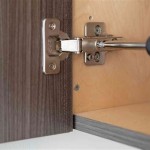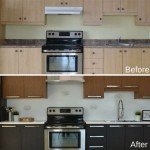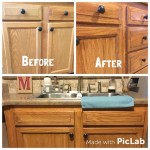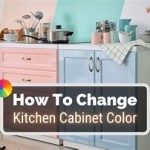Can I Use Matt Paint On Kitchen Cabinets? A Comprehensive Guide
The question of whether matt paint can be used on kitchen cabinets is a frequent one for homeowners undertaking kitchen renovations or upgrades. Matt paint, known for its low sheen and ability to conceal imperfections, offers a different aesthetic compared to gloss or semi-gloss finishes, which are traditionally favored in kitchens. This article will delve into the suitability of matt paint for kitchen cabinets, exploring its advantages, disadvantages, application considerations, and necessary preparation steps.
The standard recommendation for kitchen cabinets often leans towards paints with a higher sheen level. Gloss and semi-gloss paints are prized for their durability, ease of cleaning, and resistance to moisture, all crucial factors in a high-traffic, often humid environment like a kitchen. However, advancements in paint technology have led to the development of matt paints that possess improved durability and washability, making them a potentially viable option for kitchen cabinetry.
Understanding Matt Paint Properties
Matt paint, sometimes referred to as flat paint, is characterized by its minimal light reflection. This lack of sheen gives it a soft, velvety appearance, making it exceptionally good at hiding surface imperfections such as dents, scratches, and uneven textures. The absence of gloss also contributes to a more muted and sophisticated look, appealing to homeowners seeking a contemporary or minimalist design aesthetic.
Traditional matt paints were primarily composed of pigments and binders with a high concentration of pigment. This composition, while excellent for obscuring flaws, often resulted in a porous surface that was susceptible to staining, scuffing, and moisture damage. Early formulations of matt paint were difficult to clean and required frequent repainting, making them unsuitable for high-use areas like kitchens. However, modern matt paints often incorporate acrylic or latex resins and additives that enhance their durability and washability. These additives improve the paint's resistance to stains, mildew, and abrasion, making them a more practical choice for kitchen cabinets.
The choice between oil-based and water-based (latex or acrylic) matt paint is also crucial. Oil-based paints are known for their hardness and excellent leveling properties, resulting in a smooth finish. However, they have a longer drying time, emit strong odors, and require mineral spirits for cleanup. Water-based paints, on the other hand, are low-VOC (volatile organic compounds), dry quickly, and clean up easily with soap and water. Modern acrylic latex matt paints are highly durable and are often the preferred choice for kitchen cabinets due to their user-friendliness and environmental friendliness.
Advantages of Using Matt Paint on Kitchen Cabinets
Despite the traditional preference for glossier finishes, using matt paint on kitchen cabinets offers several distinct advantages.
Firstly, the ability to conceal imperfections is a significant benefit. If the cabinets have dings, dents, or an uneven surface, matt paint can effectively mask these flaws, creating a more uniform and visually appealing appearance. This is particularly advantageous when refinishing older cabinets, as extensive repairs may not be necessary to achieve a satisfactory outcome.
Secondly, matt paint provides a sophisticated and contemporary look. The low sheen finish exudes elegance and can complement a variety of kitchen styles, from modern minimalist to farmhouse chic. It can create a calming and understated atmosphere, especially when paired with natural materials like wood or stone.
Thirdly, matt paint can minimize glare and light reflection. In kitchens with ample natural light, glossy cabinets can create excessive glare, which can be distracting or even uncomfortable. Matt paint absorbs light, reducing glare and creating a more comfortable and visually balanced environment.
Finally, modern matt paints are increasingly durable and washable. While traditional matt paints were prone to staining and scuffing, advancements in paint technology have resulted in formulations that are specifically designed for high-traffic areas. These durable matt paints can withstand regular cleaning and are resistant to common kitchen stains, making them a practical choice for busy households.
Disadvantages and Considerations When Using Matt Paint
While matt paint offers several benefits, it's crucial to consider the potential disadvantages and specific requirements before applying it to kitchen cabinets.
Traditionally, the primary concern with matt paint was its lower durability and washability compared to glossier finishes. Although modern formulations have improved, they may still require more frequent cleaning and maintenance than semi-gloss or gloss paints. Spills and splatters should be cleaned promptly to prevent staining, and abrasive cleaners should be avoided to prevent damage to the finish.
Another consideration is the application process. Matt paint can sometimes be more challenging to apply evenly than glossier paints. Due to its low sheen, brush strokes and roller marks can be more visible, especially if the paint is not applied smoothly. Proper surface preparation, including thorough sanding and priming, is essential to ensure a uniform and professional-looking finish. Using high-quality brushes and rollers specifically designed for smooth finishes can also minimize application issues.
The specific type of matt paint used is also critical. Not all matt paints are created equal. It is essential to choose a matt paint that is specifically formulated for kitchen cabinets or high-traffic areas. These paints typically contain additives that enhance their durability, stain resistance, and washability. Reading the product label and consulting with a paint professional can help ensure that the chosen paint is suitable for the intended application.
Furthermore, the overall kitchen design and lifestyle should be taken into account. If the kitchen is used heavily and prone to frequent spills and messes, a more durable and easily cleanable finish, such as a semi-gloss or satin, might be a more practical choice. However, if the kitchen receives moderate use and a sophisticated, low-sheen aesthetic is desired, matt paint can be a viable option.
Preparation and Application Techniques for Matt Paint on Kitchen Cabinets
Proper preparation and application techniques are essential for achieving a durable and aesthetically pleasing matt finish on kitchen cabinets.
The first step is to thoroughly clean and degrease the cabinets. Kitchen cabinets tend to accumulate grease, grime, and food residue, which can interfere with paint adhesion. Use a strong degreaser or a mixture of soap and water to scrub the cabinets thoroughly. Rinse with clean water and allow them to dry completely.
Next, sand the cabinets to create a smooth and even surface. Sanding removes any existing imperfections and provides a better surface for the primer to adhere to. Use a medium-grit sandpaper (120-150 grit) to sand the entire surface of the cabinets. For cabinets with a glossy finish, use a coarser grit sandpaper (80-100 grit) to dull the surface. After sanding, remove all dust with a tack cloth or a vacuum cleaner.
Apply a high-quality primer to the cabinets. Primer seals the surface, improves paint adhesion, and helps to prevent stains from bleeding through the finish coat. Use a primer that is specifically designed for cabinets or furniture. Apply the primer in thin, even coats using a brush, roller, or sprayer. Allow the primer to dry completely according to the manufacturer's instructions.
Once the primer is dry, lightly sand the surface with a fine-grit sandpaper (220-grit) to remove any imperfections. Remove all dust with a tack cloth or a vacuum cleaner.
Apply the matt paint in thin, even coats. Use a high-quality brush, roller, or sprayer to apply the paint. Avoid applying the paint too thickly, as this can result in drips and runs. Allow each coat of paint to dry completely before applying the next coat. Two or three coats of paint may be necessary to achieve full coverage and a uniform finish.
After the final coat of paint has dried, consider applying a clear topcoat for added protection. A clear topcoat can enhance the durability of the finish and make it easier to clean. Choose a clear topcoat that is compatible with the matt paint and follow the manufacturer's instructions for application.
Allow the paint to cure completely before using the kitchen cabinets. The curing process can take several days or even weeks, depending on the type of paint used. Avoid placing heavy objects on the cabinets or exposing them to excessive moisture during the curing process.
By following these preparation and application techniques, it is possible to achieve a beautiful and durable matt finish on kitchen cabinets. While matt paint requires more careful application and potentially more frequent cleaning than glossier finishes, the aesthetic benefits and the availability of durable matt paint formulations make it a viable option for homeowners seeking a unique and sophisticated kitchen design.

Matte Finish Kitchen Cabinets A Comprehensive Guide Fabdiz

Matt Finish Kitchen Cabinets Ultimate Pros And Cons Experts

Best Kitchen Cabinet Paint Finish For Professional Results Pennies A Fortune

Best Kitchen Cabinet Paint Finish For Professional Results Pennies A Fortune

How To Paint Laminate Kitchen Cabinets Perfect Finish Tips

High Gloss Kitchen Or Matt Warehouse

Rust Oleum Cafe Luxe Matt Kitchen Cupboard Paint 750ml

How To Paint Laminate Kitchen Cabinets Perfect Finish Tips

Rust Oleum Natural Charcoal Matt Kitchen Cupboard Paint 750ml

High Gloss Kitchen Or Matt Warehouse
Related Posts








